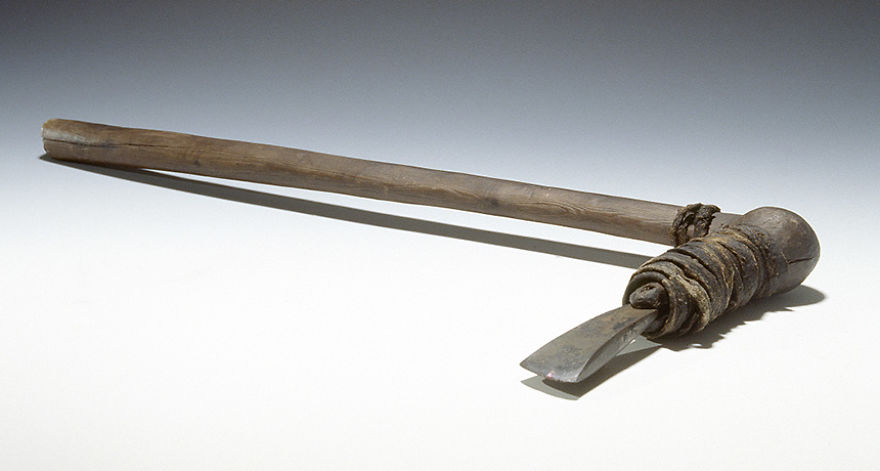
28 Years Ago, A Couple Hiking In The Alps Found A Perfectly Preserved Corpse, And We’re Still Solving His 5300-Year-Old Murder Case Today
On September 19 1991, German hikers Erika and Helmut Simon discovered a corpse at an elevation of 3210 miles above sea level. Only his upper body protruded from the ice, and the Simons initially assumed that this was the victim of a mountaineering accident, one of the many unfortunate hikers who perished on the high alpine slopes between Italy and Austria. They were soon shocked to discover that they had found the best preserved remains ever for a corpse 5300 years old- even his eyeballs were intact. The body was later known as Ötzi, named for his discovery in the Ötzal mountains. Due to a skirmish that took place several days prior to his death, Ötzi was violently killed and became frozen in a glacier, perfectly preserving his body and equipment, and he is now one of the most influential and important archaeological finds of all time, providing researchers with an abundance of important, and often previously unknown, information to help piece together Ötzi’s murder and life in the Chalcolithic age.
A monument in the Ötztal alps between Austria and Italy marks the spot where Ötzi’s body was discovered.
Image credits: hoehepunkt-tirols.oetztal.com
Several days prior to his death, Ötzi left his village, a small settlement in the valley about 37 miles below his discovery point. Ötzi lived in a time when agriculture was being developed and goats were beginning to be domesticated, but Ötzi’s society still had to rely heavily on hunting and gathering. However, at the time Ötzi left his village, the only weapons he carried on him were a small dagger measuring 13 centimeters long, its 12-centimeter sheath, an unfinished bow stave, and a deer-hide quiver containing 14 arrow shafts, only 2 of which were affixed with arrowheads.
Rather, it is believed that Ötzi was involved in a conflict that took place in the valley a few days prior to his death. It is believed that Ötzi won this initial fight, but, while in the mountains, was ambushed and murdered, possibly by his opponent in this original conflict.
Image credits: blogs.discovermagazine.com
Austrian archaeologist Konrad Spindler had been studying Ötzi for some time when he presented his Disaster Theory. In Spindler’s version, Ötzi was a shepherd, who was on the run at the time of his death. Spindler believed that during autumn, Ötzi was returning with his animals, but reached the conflict upon returning to his village. CAT scans revealed broken ribs, and Spindler’s theory was that Ötzi had actually lost the battle, but escaped. He fled to the mountains but eventually died of hypothermia.
This image is Ötzi’s preserved remains at the South Tyrol Museum of Archaeology where they now reside.
In 2009, radiologist Paul Gostner found something that had been missing since his discovery: his stomach.
Image credits: img.newatlas.com
The missing piece was Ötzi’s stomach. urprisingly, prior to this, Ötzi’s stomach had not been evident on previous scans. The reason other researchers had been unable to find Ötzi’s stomach was that it had been pushed up from 5,300 years of laying stomach-down under tons of ice, and it rested where his lower lungs would be. Gostner was able to locate the stomach on more modern scans. Scientists extracted the stomach contents for study which according to National Geographic were “yellowish to brownish colored and mushy.” The contents were analyzed to find that Ötzi’s last meal had been elaborate and cooked two hours or less prior to his death, providing strong evidence that Ötzi was not, in fact, on the run at the time of his death, as it is unlikely that he would have taken the time to cook such an extensive meal if he was fleeing.
Ötzi’s last meal consisted of pollen, einkorn (wheat) bread, and ibex meat (National Geographic). Ibex are a type of wild goat, and in Ötzi’s day they would have been a quite common food source. Bits of ash containing traces of the meat were also found in his intestine, suggesting that the meat had been cooked over an open flame. However, animal hair and fly parts also in his intestine suggested that Ötzi was not overly concerned with cleaning the meat before consuming it.
The pollen was from hophornbeam trees, which only bloom in the late spring and early summer, thereby refuting the hypothesis that Ötzi had died in the winter from hypothermia.
The new theory was that Ötzi died when caught in a storm in the mountains. Once again, Paul Gostner made an unprecedented discovery which would change everything.
Image credits: www.iceman.it
Gostner discovered an arrowhead lodged in Ötzi’s shoulder, a finding that had been missed by many scientists before. The arrowhead could have easily been mistaken for a piece of bone, providing an explanation as to why it had been previously gone unnoticed. With the finding of the arrowhead, the new conclusion, and the one that persists today, was that Ötzi had been murdered. The angle of entry of the arrowhead suggested that he had been shot, unsuspectingly, from behind and from a position slightly below his. The arrowhead lodged in his shoulder hitting a large artery, and Ötzi would have very quickly bled to death leading to the theory that Ötzi was murdered. The motive is still unclear, but the most popular theory is that Ötzi’s murder was an extension of the conflict in the valley.
At the time of Ötzi’s discovery, several items had been found with him. Now, combined with the new theory of murder, one of them, his rare copper axe,would help formulate several new theories about who the Iceman may have been, as well as completely altering how we thought about these ancient time periods.
Prior to Ötzi’s discovery, his era had been classified as the late Stone age. However, one of many valuable artifacts found with Ötzi was a copper axe. The axe consisted of a copper blade bound to the handle with pitch and secured with hide straps. This meant that humans had been using copper for nearly 1,000 years longer than originally thought, completely remaking the map of time periods and classifying the time of Ötzi’s life as part of the early Chalcolithic (copper) age. The fact that Ötzi’s killer did not take his axe rules out robbery as a motive for the murder. The murderer also pulled the arrow shaft from Ötzi’s body, and with these facts combined, it suggests that the killer did not want to be identified as Ötzi’s murderer, since if the arrow shaft remained in the body or if he returned to the village with Ötzi’s rare axe the murderer could be identified. Researchers do not know why the killer was intent on remaining anonymous, but it may provide some insight into who Ötzi was. Ötzi’s axe clearly identifies him as a man of status which may explain the murderer’s desire to remain anonymous. Because Ötzi did not have anything that identified him as a shaman, he was likely a tribal leader. He was clearly a hunter, but for most people in the Chalcolithic age, this was a daily occupation. Other than that, his role in his society remains unclear. Since he was found on an alpine ridge, it is possible that he was a trader, as it was common for traders to take this route. However, there were no items found with him that can be identified as trading goods. It is possible he was a fugitive, as it was clear his equipment had been repaired under makeshift conditions. Alternatively, based on his leggings made of Neolithic sheep hair, cattle-skin moccasins, and goat hides which were domesticated animals, Ötzi may have been a shepherd or herdsman of some kind as is proposed in Spindler’s Disaster Theory. The fact that the axe was left behind indicated the motive behind the killing was not robbery. This also caused researchers to think that perhaps the killer wanted to remain anonymous, as such a rare axe would have been easily recognizable, leading them to believe that perhaps Otzi was some sort of important figure within his community. However, despite these many varying theories, researchers cannot be sure who Ötzi was or who was behind his demise.
471views
Share on FacebookWell I for one think I can safely bet that the culprit ain't gonna be arrested
Well I for one think I can safely bet that the culprit ain't gonna be arrested

 Dark Mode
Dark Mode 

 No fees, cancel anytime
No fees, cancel anytime 






















































19
4